Resources for long-term care (LTC)
Downloadable resources for HCPs and office staff
Use this manual when prescribing AUSTEDO XR in the PointClickCare platform.
A resource created with useful information for AUSTEDO XR, including clinical data, dosing, and access and affordability support for residents in long-term care facilities.
A tool to help HCPs assess and identify residents’ involuntary movements.
Videos to help support residents with TD in LTC
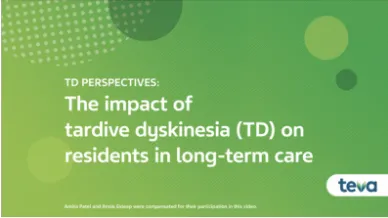
The impact of TD on residents in LTC
Dr. Patel:
The big impact of tardive dyskinesia that we see in our residents are sometimes they have difficulty with swallowing, they have difficulty with speaking, if they have really bad piano fingers, they have trouble with assisting with dressing themselves, they have difficulty with holding their fork, their spoons…if they have really bad facial movements, they're embarrassed to go in any of the activities.
We are trying to give them best quality of life in spite of being in long-term care. And what you see is they quit going to bingo. They quit going to activities, they quit going to church, they quit going out with their families—and it really affects their quality of life.
Annie:
You know, you're already on these medications for your mental states and then you're seen here getting made fun of by other patients…It's not really a good thing to feel.
Onscreen text:
Help make a difference in your facility today
Learn more about the impact of TD
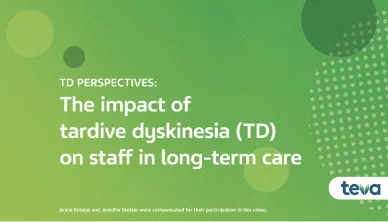
The impact of TD on staff in LTC
Jennifer:
So residents with unmanaged TD require extra time and attention, which definitely puts a burden on the staff. They have to assist with bathing, have to help get them dressed. We have to increase our monitoring for possible falls…
Annie:
It debilitates them to the point where they can't feed themselves, sometimes due to their shaking… now they’re dependent on staff to sit there and feed them.
We have already a shortage of nursing staff. We know this is a nationwide thing. And so when we can treat tardive dyskinesia, we can bring those staff numbers more available to others.
Onscreen text:
Unmanaged TD may contribute to staff turnover
Help make a difference in your facility today
Learn more about tools to assess the impact of TD

Identifying TD in LTC
Jennifer:
It's important for anyone that spends time with residents to be aware of TD and what those movements look like…
Dr. Patel:
The beauty of working in a long-term care setting is that we work as a team. So if anybody, whether it is nursing staff, activity staff, social worker, or even the housekeeping staff, if they see the impact of this that they should be really reporting this…
Jennifer:
Teva has made this Tear Pad that anyone can easily use, our nurses, even our STNAs, that really hits on all the different movements and what exactly they'll see…
Annie:
Even if you don’t have this…you can communicate this in any way—you can do it verbally, you can write the symptoms down that you see. Just making sure that you let someone know what you see, as far as a nurse or a doctor; that way we can start managing the signs and symptoms early on…
Onscreen text:
Help make a difference in your facility today
Learn more about identifying, assessing, and treating TD
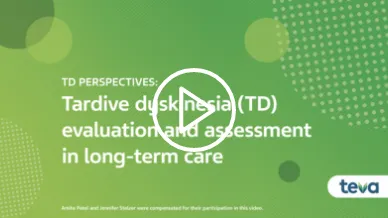
TD evaluation and assessment in LTC
Dr. Patel:
There's a requirement in long-term care to do a mandatory AIMS assessment on every resident who is on antipsychotic or any other dopamine receptor blocking agents…that really helps us to look at not only if the TD movements are present, but also to assess severity.
Dr. Patel:
So we do a formal AIMS exam at least every six months. If some residents have abnormal movements that we are very highly suspicious of tardive dyskinesia, then we do a formal AIMS exam at least every three months…
Jennifer:
So the protocol for monitoring and assessing TD in patients, anyone who's on an antipsychotic, we have to do a baseline AIMS assessment, which assesses for those abnormal movements. And then we have to reassess that every six months.
Jennifer:
So with that being said, when someone has been on an antipsychotic in the past, they're no longer on it, they're not going to trigger to do the AIMS assessment. And that's why we have to educate the staff so they know what it looks like because…if you've ever been on an antipsychotic, you can get TD.
Onscreen text:
Any resident who has been on an antipsychotic is at risk for TD
Help make a difference in your facility today
Learn more about identifying, assessing, and treating TD
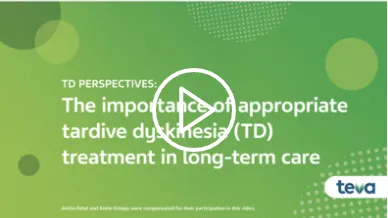
The importance of appropriate TD treatment in LTC
Annie:
So I think appropriate treatment for TD is super important because you know, once again, going towards the falls, like, falls can cause a lot of damage. You can fall and break a hip, you can fall and break an arm. Having the proper treatment for TD takes a little bit of that away.
Disclaimer at bottom of screen:
No clinical trials have been conducted to demonstrate that treating TD affects the outcomes discussed.
Annie:
They might not be wheelchair bound necessarily. They might be able to walk with a walker. They have a little bit more independence.
Dr. Patel:
I have treated a lot of residents with tardive dyskinesia in a long-term care setting, but one particular resident comes to mind.
Dr. Patel:
When I saw her and recognized she had tardive dyskinesia and initiated treatment…she had great improvement in her symptoms. Now she was able to play bingo and actually start coloring, go and put her makeup on by herself, assist with dressing, and she is really having much improved quality of life.
Disclaimer at bottom of screen:
No clinical trials have been conducted to demonstrate that treating TD affects the outcomes discussed.
Onscreen text:
Help make a difference in your facility today
Learn more about identifying, assessing, and treating TD
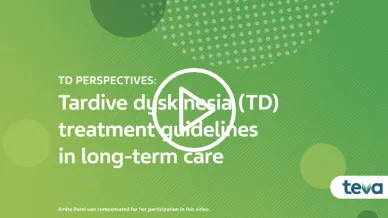
TD treatment guidelines in LTC
Dr. Patel:
So, APA recommended treatment for tardive dyskinesia is with VMAT2 inhibitors.
If patients are treated wrongly for tardive dyskinesia with, for example, benztropine…you are not going to help the tardive dyskinesia.
I have seen a lot of residents in the past being treated for tardive dyskinesia with anticholinergics because we did not have treatment for tardive dyskinesia with VMAT2 inhibitors.
Anticholinergic agents are not FDA approved for treatment of tardive dyskinesia, and in residents with tardive dyskinesia they can make these movements worse.
Onscreen text:
Help make a difference in your facility today
Learn more about identifying, assessing, and treating TD

Key takeaways on TD in LTC
Jennifer:
I absolutely feel like TD goes underdiagnosed or not prioritized. I think the important thing for people to know is you don't have to be on an antipsychotic to have TD. You just had to have been on it at one time. And so I think that people don't know to make the connection sometimes, and it's vitally important to their quality of life.
Onscreen text:
785,000 Americans with TD ~85% are undiagnosed
Annie:
So I think the actions that we need to bring to long-term care is just education to our staff. You know, during these staff meetings, have a segment on TD explaining what are the signs and symptoms, what is the AIMS test? I mean, a lot of people don't even know what an AIMS test means. In just going through the AIMS test, you get to understand all the different signs and symptoms.
Dr. Patel:
We should be training all LTC staff on what tardive dyskinesia looks like because in long-term care, we all work as a team and everybody's involved in noticing if there is any change in resident status.
So I would say if you see something, say something.
Onscreen text:
Anyone can help identify TD
Help make a difference in your facility today
Learn more about identifying, assessing, and treating TD
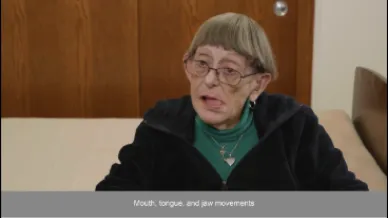
TD in Long-Term Care: Movements
Onscreen text:
Mouth, tongue, and jaw movements
Onscreen text:
Orofacial TD: Orofacial movements
Onscreen text:
TD affecting the trunk
Onscreen text:
Movements in hands
Onscreen text:
Movements in foot
TD-41588 November 2024
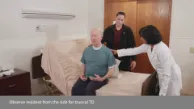
TD in Long-Term Care: Abnormal Involuntary Movement Scale Modifications
Onscreen text:
Have an assistant to prevent falls
Actor portrayal of a resident
Onscreen text:
Observe resident from the side for truncal TD
TD-41429 March 2024
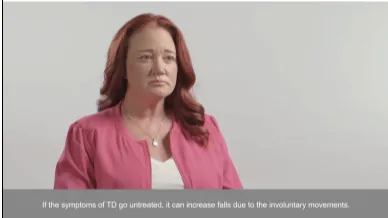
TD in Long-Term Care: Star Rating
Onscreen text and VoiceOver:
If the symptoms of TD go untreated, it can increase falls due to the involuntary movements.
Onscreen text and VoiceOver:
Emergency department visits, weight loss.
Onscreen text and VoiceOver:
Puts them at increased risk for being a choking hazard, and in the long-term care setting
Onscreen text and VoiceOver:
we are under regulations of reporting falls with major injuries and emergency department visits, weight loss.
Onscreen text and VoiceOver:
It all gets calculated and that's what gives us our star rating.
Onscreen text and VoiceOver:
The higher our numbers are in those of things, it decreases our star rating.
Onscreen text and VoiceOver:
So, it's important to identify TD symptoms
Onscreen text and VoiceOver:
and to help people we identify with those movements to get them treatment.
Onscreen text:
TD-41586 November 2024
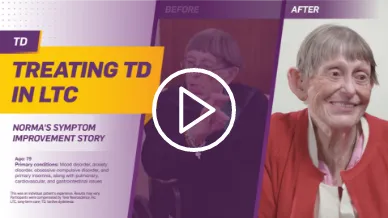
Treating TD in LTC: Norma’s symptom improvement story
Onscreen text:
TREATING TD IN LTC
NORMA’S SYMPTOM IMPROVEMENT STORY
Age:79
Primary conditions: Mood disorder, anxiety disorder, obsessive-compulsive disorder, and primary insomnia, along with pulmonary, cardiovascular, and gastrointestinal issues
Disclaimer on bottom of screen:
This was an individual patient’s experience. Results may vary. Participants were compensated by Teva Neuroscience, Inc.
LTC, long-term care; TD, tardive dyskinesia.
Onscreen text:
Norma is an LTC resident with TD. Before treatment, she had a moderate Abnormal Involuntary Movement Scale (AIMS) score of 7.
Her involuntary movements were significantly impacting her physical, psychological, and social health.
Dr. Patel:
I was given consultation on Norma initially for treatment of her psychiatric condition. And the first time I saw her is when I noticed she had symptoms of tardive dyskinesia.
Her ability to swallow was affected. She had trouble with a lot of drooling because of her tardive dyskinesia and tongue movements and jaw movements. So she constantly had to carry a washcloth and wipe her mouth all the time, and she was embarrassed by it. She was always scared that she would choke.
Onscreen text:
DR. AMITA PATEL, MD
GERIATRIC PSYCHIATRIST IN LTC
Dr. Patel:
Norma’s tardive dyskinesia movements were severe enough that it really destabilized her underlying mental health condition, and I had to adjust her psychoactive medications for it.
Onscreen text:
KIM MIDDLETON
DIRECTOR OF NURSING IN LTC
Kim:
I think the movements affected Norma physically. Functionally, she needed more help with her ADLs or her activities of daily living, such as getting dressed, toileting, even just brushing her teeth—just the everyday functions of her life.
Onscreen text:
JENNIFER
NORMA’S DAUGHTER
Jennifer:
I talk to my mom a lot, and when I can't understand her, you know, that's hard for me. It's definitely hard for her because I have to have her repeat things all the time.”
The physical activities changed. She kind of had to stop, you know, crocheting and certain things like that.
Onscreen text:
Any resident who has taken or is currently taking an antipsychotic is at risk for developing TD.
Fortunately, Norma’s care team recognized her TD symptoms and the negative impact they were having on her life.
Dr. Patel:
The symptoms that we saw in Norma are not only typical for Norma, we see that quite often in other residents that I treat with tardive dyskinesia in long-term care facility. Just because residents are in long-term care facility, doesn't mean they don't deserve maximum quality of life.
Treating TD was really important for Norma because TD was not only affecting her socially, physically, and psychologically, but it was worsening her depression and anxiety.
It was very important for me to pick the correct medication, where there is no drug interaction with the current regimen she's on because she was quite stable on her current mental health medication, and I didn't want to adjust any of her current psychoactive medication, if possible.
Onscreen Indication and Black Box Warning:
AUSTEDO XR® and AUSTEDO® are indicated in adults for the treatment of tardive dyskinesia and for the treatment of chorea associated with Huntington's disease.
IMPORTANT SAFETY INFORMATION
Depression and Suicidality in Patients with Huntington’s Disease: AUSTEDO XR and AUSTEDO can increase the risk of depression and suicidal thoughts and behavior (suicidality) in patients with Huntington’s disease. Balance the risks of depression and suicidality with the clinical need for treatment of chorea. Closely monitor patients for the emergence or worsening of depression, suicidality, or unusual changes in behavior. Inform patients, their caregivers, and families of the risk of depression and suicidality and instruct them to report behaviors of concern promptly to the treating physician. Exercise caution when treating patients with a history of depression or prior suicide attempts or ideation. AUSTEDO XR and AUSTEDO are contraindicated in patients who are suicidal, and in patients with untreated or inadequately treated depression.
Please see additional Important Safety Information at the end of this video.
Dr. Patel:
I have had a lot of experience using AUSTEDO XR in other patients. I've had great results with this medication, especially in Norma’s case.
It was easy to add AUSTEDO XR to the current medications that Norma was taking. I could do a slow titration and watch for any side effects.
Onscreen text:
Once Norma began treatment, she saw a significant improvement in her movements—and so did those around her.
Onscreen text:
Before treatment AIMS score of 7
After treatment AIMS score of 3
Dr. Patel:
Norma is currently on 48 milligrams and her current AIMS score is 3. But if you really talk about the improvement she has had, it really has given her better quality of life. She is now able to speak better. We don't have to ask her to repeat herself all the time. She doesn't have to carry the washcloth to wipe her lips all the time. She is not afraid of choking. Her movements of her jaw and her fingers are so much better. She's not embarrassed. She's not afraid that people are going to make fun of her.
Kim:
I could tell that AUSTEDO XR was making a difference in Norma's life.
I noticed that she was being involved more in the social activities due to the involuntary movements decreasing. So, I feel like Norma's quality of life was improving.
I think her movement improvement has made it easier to care for her because she is more independent. She can do more of those, you know, daily things on her own.
Jennifer:
My feeling since she started taking AUSTEDO XR, is relief. I don't have to worry quite as much about her possibly hurting herself or even with eating or drinking and choking. And I feel I'm proud of her for her leaps and bounds.
It has been a very noticeable change. As time goes by, she can do a little bit more and a little bit more. And when she handed me that little blanket that she made, I was really shocked because the stitching was really great.
When I see Mom's progress, it just fills me with joy. It's a relief to know that she is getting the help, the care, and the medications that she needs.
Kim:
So it's important to identify TD symptoms and to help people we identify with those movements to get them treatment, to decrease the risk of them falling, or having to go to the emergency department, or losing weight.
I think the care team, I can probably speak for all of them. When you see someone like Norma improve their quality of life, I think I can say that it just brings a lot of joy to our hearts and our lives. And it just reaffirms why we come here every day and why we do what we do.
Onscreen text:
Learn more about AUSTEDO XR and how it can make a difference for your residents with TD.
Onscreen ISI scroll:
INDICATIONS AND USAGE
AUSTEDO XR and AUSTEDO are indicated in adults for the treatment of tardive dyskinesia and for the treatment of chorea associated with Huntington's disease.
IMPORTANT SAFETY INFORMATION
Depression and Suicidality in Patients with Huntington’s Disease: AUSTEDO XR and AUSTEDO can increase the risk of depression and suicidal thoughts and behavior (suicidality) in patients with Huntington’s disease. Balance the risks of depression and suicidality with the clinical need for treatment of chorea. Closely monitor patients for the emergence or worsening of depression, suicidality, or unusual changes in behavior. Inform patients, their caregivers, and families of the risk of depression and suicidality and instruct them to report behaviors of concern promptly to the treating physician. Exercise caution when treating patients with a history of depression or prior suicide attempts or ideation. AUSTEDO XR and AUSTEDO are contraindicated in patients who are suicidal, and in patients with untreated or inadequately treated depression.
Contraindications: AUSTEDO XR and AUSTEDO are contraindicated in patients with Huntington’s disease who are suicidal, or have untreated or inadequately treated depression. AUSTEDO XR and AUSTEDO are also contraindicated in: patients with hepatic impairment; patients taking reserpine or within 20 days of discontinuing reserpine; patients taking monoamine oxidase inhibitors (MAOIs), or within 14 days of discontinuing MAOI therapy; and patients taking tetrabenazine or valbenazine.
Clinical Worsening and Adverse Events in Patients with Huntington’s Disease: AUSTEDO XR and AUSTEDO may cause a worsening in mood, cognition, rigidity, and functional capacity. Prescribers should periodically re-evaluate the need for AUSTEDO XR or AUSTEDO in their patients by assessing the effect on chorea and possible adverse effects.
QTc Prolongation: AUSTEDO XR and AUSTEDO may prolong the QT interval, but the degree of QT prolongation is not clinically significant when AUSTEDO XR or AUSTEDO is administered within the recommended dosage range. AUSTEDO XR and AUSTEDO should be avoided in patients with congenital long QT syndrome and in patients with a history of cardiac arrhythmias.
Neuroleptic Malignant Syndrome (NMS), a potentially fatal symptom complex reported in association with drugs that reduce dopaminergic transmission, has been observed in patients receiving tetrabenazine. The risk may be increased by concomitant use of dopamine antagonists or antipsychotics. The management of NMS should include immediate discontinuation of AUSTEDO XR and AUSTEDO; intensive symptomatic treatment and medical monitoring; and treatment of any concomitant serious medical problems.
Akathisia, Agitation, and Restlessness: AUSTEDO XR and AUSTEDO may increase the risk of akathisia, agitation, and restlessness. The risk of akathisia may be increased by concomitant use of dopamine antagonists or antipsychotics. If a patient develops akathisia, the AUSTEDO XR or AUSTEDO dose should be reduced; some patients may require discontinuation of therapy.
Parkinsonism: AUSTEDO XR and AUSTEDO may cause parkinsonism in patients with Huntington’s disease or tardive dyskinesia. Parkinsonism has also been observed with other VMAT2 inhibitors. The risk of parkinsonism may be increased by concomitant use of dopamine antagonists or antipsychotics. If a patient develops parkinsonism, the AUSTEDO XR or AUSTEDO dose should be reduced; some patients may require discontinuation of therapy.
Sedation and Somnolence: Sedation is a common dose-limiting adverse reaction of AUSTEDO XR and AUSTEDO. Patients should not perform activities requiring mental alertness, such as operating a motor vehicle or hazardous machinery, until they are on a maintenance dose of AUSTEDO XR or AUSTEDO and know how the drug affects them. Concomitant use of alcohol or other sedating drugs may have additive effects and worsen sedation and somnolence.
Hyperprolactinemia: Tetrabenazine elevates serum prolactin concentrations in humans. If there is a clinical suspicion of symptomatic hyperprolactinemia, appropriate laboratory testing should be done and consideration should be given to discontinuation of AUSTEDO XR and AUSTEDO.
Binding to Melanin-Containing Tissues: Deutetrabenazine or its metabolites bind to melanin-containing tissues and could accumulate in these tissues over time. Prescribers should be aware of the possibility of long-term ophthalmologic effects.
Common Adverse Reactions: The most common adverse reactions for AUSTEDO (>8% and greater than placebo) in a controlled clinical study in patients with Huntington’s disease were somnolence, diarrhea, dry mouth, and fatigue. The most common adverse reactions for AUSTEDO (4% and greater than placebo) in controlled clinical studies in patients with tardive dyskinesia were nasopharyngitis and insomnia. Adverse reactions with AUSTEDO XR extended-release tablets are expected to be similar to AUSTEDO tablets.
Please see full Prescribing Information, including Boxed Warning, at AUSTEDOhcp.com.
For more videos, visit the YouTube page.
For more videos, visit the YouTube page.
PointClickCare® is a registered trademark of PointClickCare Technologies Inc.




